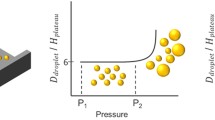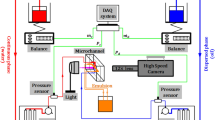Abstract
Microchannel (MC) emulsification is a promising technique to produce monodisperse emulsions by spontaneous interfacial-tension-driven droplet generation. The purpose of this study was to systematically characterize the effect of temperature on droplet generation by MC emulsification, which is a major uncharted area. The temperature of an MC emulsification module was controlled between 10 and 70°C. Refined soybean oil was used as the dispersed phase and a Milli-Q water solution containing sodium dodecyl sulfate (1 wt%) as the continuous phase. Monodisperse oil-in-water (O/W) emulsions with a coefficient of variation below 4% were produced, and at all the operating temperatures, their average droplet diameter ranged from 32 to 38 μm. We also investigated the effect of flow velocity of the dispersed phase on droplet generation characteristics. The maximum droplet generation rate (frequency) from a channel at 70°C exceeded that at 10°C by 8.1 times, due to the remarkable decrease in viscosity of the two phases. Analysis using dimensionless numbers indicated that the flow of the dispersed phase during droplet generation could be explained using an adapted capillary number that includes the effect of the contact angle of the dispersed phase to the chip surface.










Similar content being viewed by others
Abbreviations
- A disk :
-
Initial disk area of a dispersed phase (m2)
- A drop :
-
Droplet surface area (m2)
- A MC :
-
Channel cross-sectional area (m2)
- Ca d :
-
Capillary number of a dispersed phase (-)
- \( Ca_{\text{d}}^{\theta } \) :
-
Adapted capillary number of a dispersed phase (-)
- CV:
-
Coefficient of variation (-)
- d drop :
-
Droplet diameter (m)
- \( \bar{d} \) :
-
Dimensionless droplet diameter (-)
- d n,drop :
-
Number-weighted mean droplet diameter (m)
- d MC :
-
Channel hydraulic diameter (m)
- f MC :
-
Frequency per channel (s−1)
- f MC,max :
-
Maximum frequency per channel (s−1)
- g :
-
Acceleration due to gravity (m/s2)
- Δh d :
-
Height of a dispersed phase chamber (m)
- h terrace :
-
Terrace height (m)
- ΔP d :
-
Pressure applied to a dispersed phase (Pa)
- ΔP d,bt :
-
Breakthrough pressure of a dispersed phase (Pa)
- T C :
-
Celsius temperature (ºC)
- t det :
-
Detachment time (s)
- t gen :
-
Droplet generation time (s)
- U d,MC :
-
Flow velocity of a dispersed phase inside a channel (m)
- γ:
-
Dynamic interfacial tension (N/m)
- γ0 :
-
Interfacial tension between the two phases in the absence of surfactant (N/m)
- κ:
-
Relative rate of surfactant creation (s)
- τd :
-
Diffusion of surfactant molecules (s)
- γeq :
-
Equilibrium interfacial tension (N/m)
- ηc :
-
Viscosity of a continuous phase (Pa s)
- ηd :
-
Viscosity of a dispersed phase (Pa s)
- θd :
-
Contact angle of a dispersed phase (°)
- ξ:
-
Viscosity ratio of a dispersed phase to a continuous phase (-)
- ρd :
-
Density of a dispersed phase (kg/m3)
- σ:
-
Standard deviation (m)
References
Alfrey T, Bartovics A, Mark H (1942) The effect of temperature and solvent type on the intrinsic viscosity of high polymer solutions. J Am Chem Soc 64:1557–1560
Anna SL, Bontoux N, Stone HA (2003) Formation of dispersions using “flow focusing” in microchannels. Appl Phys Lett 82:364–366
Ax K, Mayer-Miebach E, Link B, Schuchmann H, Schubert H (2003) Stability of lycopene in oil-in-water emulsions. Eng Life Sci 3:199–201
Brouzes D, Medkova M, Savenelli N, Marran D, Twardowski M, Hutchison JB, Rothberg JM, Link DR, Perrimon N, Samuels M (2009) Droplet microfluidic technology for single-cell high-throughput screening. PNAS 106:14195–14200
Chuah AM, Kuroiwa T, Kobayashi I, Zhang X, Nakajima M (2010) Preparation of uniformly sized alginate microspheres using the novel combined methods of microchannel emulsification and external gelation. Colloids Surf A 351:9–17
Comiskey B, Albert JD, Yoshizawa H, Jacobson J (1998) An electrophoretic ink for all-printed reflective electronic displays. Nature 394:253–255
Iwamoto S, Nakagawa K, Sugiura S, Nakajima M (2002) Preparation of gelatin microbeads with a narrow size distribution using microchannel emulsification. AAPS PharmSciTech 3:25
Kawakatsu T, Kikuchi Y, Nakajima M (1997) Regular sized cell creation in microchannel emulsification by visual microprocessing method. J Am Oil Chem Soc 74:317–321
Kawakatsu T, Trägårdh G, Trägårdh Ch (2001) Production of W/O/W emulsions and S/O/W pectin microcapsules by microchannel emulsification. Colloids Surf A 189:257–264
Kikuchi Y, Sato K, Kaneko T (1992) Optically accessible microchannels formed in a single-crystal silicon substrate for studies of blood rheology. Microvasc Res 4:226–240
Kobayashi I, Nakajima M (2006) Generation and multiphase flow of emulsions in microchannels. In: Kockmann N (ed) Micro process engineering. Wiley-VCH, Weinheim
Kobayashi I, Nakajima M, Chun K, Kikuchi Y, Fujita H (2002) Silicon array of elongated through-holes for monodisperse emulsion droplets. AIChE J 48:1639–1644
Kobayashi I, Nakajima M, Mukataka S (2003) Preparation characteristic of oil-in-water emulsion using differently charged surfactants in straight-trough microchannel emulsification. Colloids Surf A 229:33–41
Kobayashi I, Mukataka S, Nakajima M (2005) Novel asymmetric through-hole array microfabricated on a silicon plate for formulating monodisperse emulsions. Langmuir 21:7629–7632
Kobayashi I, Uemura K, Nakajima M (2007) Formulation of monodisperse emulsions using submicron-channel arrays. Colloids Surf A 296:285–289
Kobayashi I, Takano T, Maeda R, Wada Y, Uemura K, Nakakima M (2008) Straight-through microchannel devices for generating monodisperse emulsion droplets several microns in size. Microfluid Nanofluid 4:167–177
Kobayashi I, Hori Y, Uemura K, Nakajima M (2010) Production characteristics of large soybean oil droplets by microchannel emulsification using asymmetric through holes. Jpn J Food Eng 11:37–48
Köster S, Angilė FE, Duan H, Agresti JJ, Wintner A, Schmitz C, Rowat AC, Merten CA, Pisignano D, Griffiths AD, Weitz DA (2008) Drop-base microfluidic devices for encapsulation of single cells. Lab Chip 8:1110–1115
Lucassen-Reynders EH, Kuijpers KA (1991) The role of interfacial properties in emulsification. Colloids Surf 65:175–184
Mazutis L, Baret J-C, Treacy P, Skhiri Y, Araghi AF, Ryckelynk M, Taly V, Griffiths AD (2009) Multi-step microfluidic droplet processing: kinetic analysis of an in vitro translated enzyme. Lab on a chip. doi:10.1039/b907753g
McClements DJ (2004) Food emulsions: principles, practice, and techniques, 2nd edn. CRC Press, Boca Raton, FL
Murshed SMS, Tan SH, Nguyen NT, Wong TN, Yobas L (2008) Microdroplet formation of water and nanofluids in heat-induced microfluidic T-junction. Microfluid Nanofluid 6:253–259
Neves MA, Ribeiro HS, Kobayashi I, Nakajima M (2008) Encapsulation of lipophilic bioactive molecules by microchannel emulsification. Food Biophys 3:126–131
Nguyen NT, Ting TH, Yap YF, Wong TN, Chai JCK (2007) Thermally mediated droplet formation in microchannels. Appl Phys Lett 91:084102
Nishisako T, Torii T (2008) Microfluidic large-scale integration on a chip for mass production of monodisperse droplets and particles. Lab Chip 8:287–293
Ribeiro HS, Rico LG, Badolato GG, Schubert H (2005) Production of O/W emulsions containing astaxanthin by repeat premix membrane emulsification. J Food Sci 70:E117
Ruijter M, Kölsch P, Voué M, De Coninck J, Rabe JP (1998) Effect of temperature on the dynamic contact angle. Colloids Surf 144:235–243
Schaerli Y, Hollfelder F (2009) The potential of microfluidic water-in-oil droplets in experimental biology. Mol Biosyst 5:1392–1404
Stan CA, Tang SKY, Whitesides GM (2009) Independent control of drop size and velocity in microfluidic flow-focusing generators using variable temperature and flow rate. Anal Chem 81:2399–2402
Streegmans MLJ, Schroën CGPH, Boom RM (2009) Characterization of emulsification at flat microchannel Y junctions. Langmuir 25:3396–3401
Sugiura S, Nakajima M, Tong J, Nabetani H, Seki M (2000) Preparation of monodispersed solid lipid microspheres using microchannel emulsification technique. J Colloid Interface Sci 227:95–103
Sugiura S, Nakajima M, Iwamoto S, Seki M (2001) Interfacial tension driven monodispersed droplet formation from microfabricated channel array. Langmuir 17:5562–5566
Sugiura S, Nakajima M, Kumazawa N, Iwamoto S, Seki M (2002a) Characterization of spontaneous transformation-based droplet formation during microchannel emulsification. J Phys Chem B 106:9405–9409
Sugiura S, Nakajima M, Seki M (2002b) Effect of channel structure on microchannel emulsification. Langmuir 18:5708–5712
Sugiura S, Kumazawa N, Iwamoto S, Oda T, Satake M, Nakajima M (2004) Effect of physical properties on droplet formation in microchannel emulsification. Kagakukogaku Ronbunshu 30:129–133
Sugiura S, Oda T, Izumida Y, Aoyagi Y, Satake M, Ochiai A, Ohkohchi N, Nakajima M (2005) Size control of calcium alginate beads containing living cells using micro-nozzle array. Biomaterials 26:3327–3331
Thorsen T, Roberts RW, Arnold FH, Quake SR (2001) Dynamic pattern formation in a vesicle-generating microfluidic device. Phys Rev Lett 86:4163–4166
Tong J, Nakajima M, Nabetani H, Kikuchi Y (2000) Surfactant effect on production of monodispersed microspheres by microchannel method emulsification. J Surfactants Deterg 3:285–293
Utada AS, Fernandez-Nieves A, Stone HA, Weitz DA (2007) Dripping to jetting transitions in coflowing liquid streams. Phys Rev Lett 99:094502
van der Zwan E, Schroën K, Boom RM (2009) A geometric model for the dynamics of microchannel emulsification. Langumuir 25:7320–7327
van Dijke KC, Schroën K, Boom RM (2008) Microchannel emulsification: from computational fluid dynamics to predictive analytical model. Langumuir 24:10107–10115
van Dijke K, Kobayashi I, Schroën K, Uemura K, Nakajima M, Boom R (2010) Effect of viscosities of dispersed and continuous phases in microchannel oil-in-water emulsification. Microfluid Nanofluid 9:77–85
Vlahovska PM, Danov KD, Mehreteab A, Broze G (1997) Adsorption kinetic of ionic surfactants with detailed account for the electrostatic interactions. J Colloid Interface Sci 192:194–206
Xu JH, Li SW, Tan J, Wang J, Luo GS (2006) Controllable preparation of monodisperse O/W and W/O emulsions in the same microfluidic device. Langmuir 22:7943–7946
Yobas L, Martens S, Ong W-L, Ranganathan N (2006) High performance flow-focusing geometry for spontaneous generation of monodispersed droplets. Lab Chip 6:1073–1079
Acknowledgment
This work was supported by the Food Nanotechnology Project of the Ministry of Agriculture, Forestry, and Fisheries of Japan.
Author information
Authors and Affiliations
Corresponding authors
Rights and permissions
About this article
Cite this article
Butron Fujiu, K., Kobayashi, I., Uemura, K. et al. Temperature effect on microchannel oil-in-water emulsification. Microfluid Nanofluid 10, 773–783 (2011). https://doi.org/10.1007/s10404-010-0708-y
Received:
Accepted:
Published:
Issue Date:
DOI: https://doi.org/10.1007/s10404-010-0708-y




